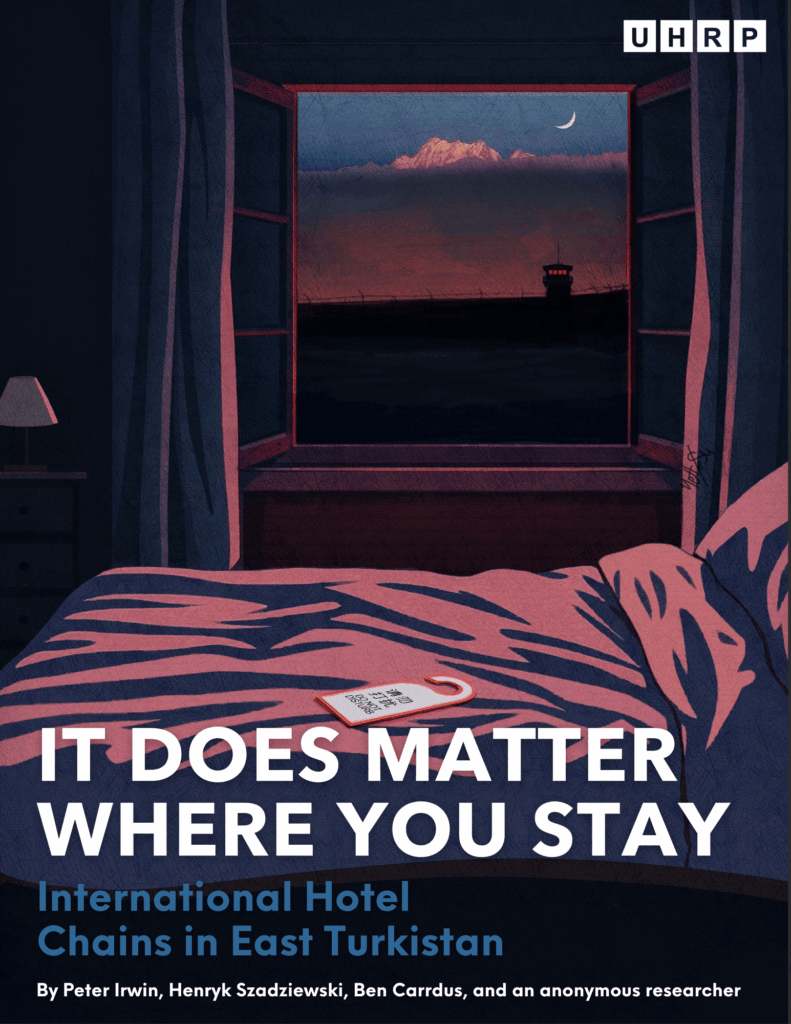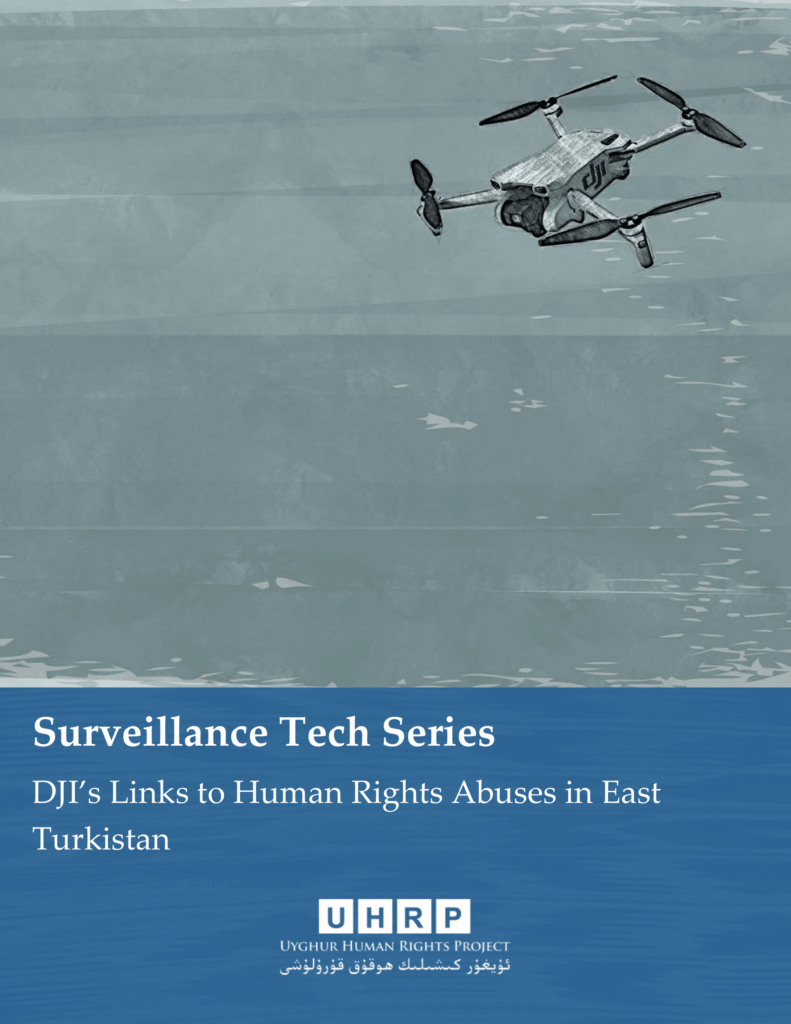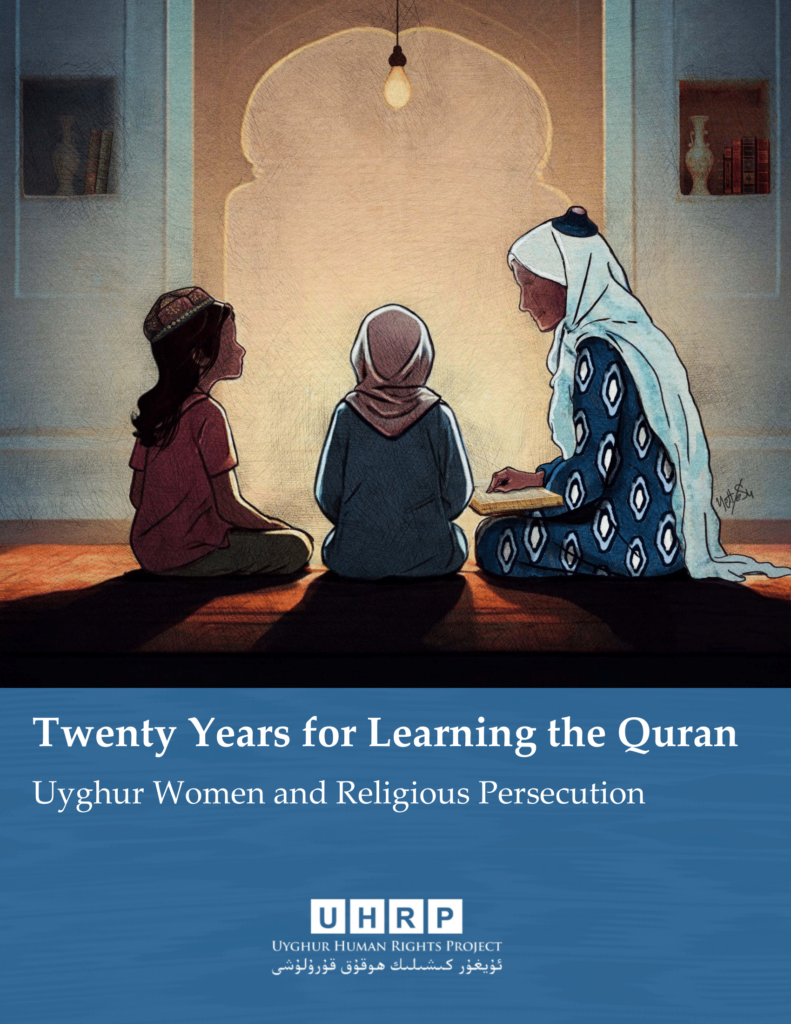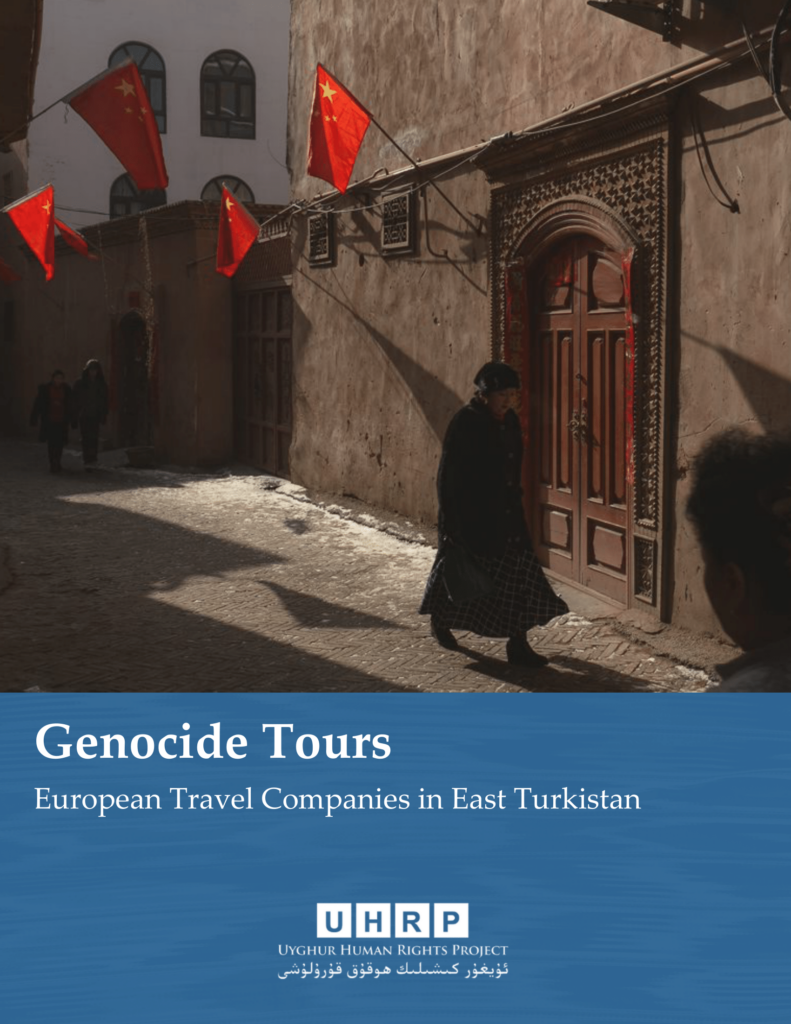A Uyghur Human Rights Project report by Elise Anderson, Nicole Morgret, and Henryk Szadziewski. Read our press statement on the report here, and download the full report here.

Key Takeaways
- A leaked document from Qaraqash provides documentary proof that people in East Turkistan are detained or deemed suspicious for legitimate and reasonable actions verifying the claims of the Uyghur diaspora and internment camp survivors.
- Reasons for suspicion and detention include: “visiting abroad,” “applied for a passport,” “applied for a passport and didn’t leave the country,” “overseas communication,” “prayed regularly,” “religious knowledge comes from grandfather,” or “had a beard.”
- Local officials decide and record these judgments, demonstrating wide-ranging arbitrary power over residents and their entire families.
- The Qaraqash Document confirms local implementation of key features of the intensive and brutal Uyghur crisis, particularly the regular use of the Integrated Joint Operations Platform for surveillance and control, the “Becoming Family” program as a tool for identifying Uyghurs who should be detained, and identification and harsh punishment of “two-faced” officials – those who are deemed to have betrayed the Party after having been appointed to serve it.

I. Introduction
This report describes and analyzes data from what we have dubbed the Qaraqash Document, a spreadsheet containing information about Uyghur internees in Bostan subdistrict, Qaraqash (also: Karakax) county, Hotan prefecture. The Qaraqash Document, which includes data that appears toh ave been gathered between 2017 and 2019, contains detailed information about the familial, social, and religious circles of internees under the jurisdiction of the Bostan subdistrict office. The purpose of the document appears to be evaluating whether the internees should remain in or be released from detention.
The Qaraqash Document provides confirmation of the veracity of eyewitness and survivor testimony, especially the reasons for detention, the systematic reliance on guilt by association to deprive individuals of their liberty, and the sorting of detainees into “standard,” “strict,” and “maximum” detention protocols. It also confirms local implementation of key features of the intensive and brutal Uyghur crisis, particularly the regular use of the Integrated Joint Operations Platform for surveillance and control, the “Becoming Family” program as a tool for identifying Uyghurs who should be detained, and identification and harsh punishment of “two-faced” officials (两面性干部), those who are deemed to have betrayed the Party after having been appointed to serve it. There is no reference to any kind of judicial process for the judgments. These are arbitrary judgments recorded by local officials, who exert tremendous arbitrary power over residents and their entire families. The authorities assess and record whether former internees’ moods and thinking are “stable,” (思想/情绪稳定), whether they can “recognize their mistakes,” (能够认识错误), have a “sincere attitude of regret” (悔过态度认真), or “present no threat” (没有现实危害).
Details in the Qaraqash Document put a human face on the continuing political terror in East Turkistan. The document provides surprisingly intimate glimpses into the life circumstances and histories of internees. These details also give important, if still limited, insight into how low-level local bureaucrats and other government employees make decisions about who is interned, why, and for how long. Uyghurs are the victims; some Uyghurs, almost certainly, are among the bureaucrats filling up these case records. Details in the Qaraqash Document paint a portrait of extra judicial internment in the Uyghur region at the hyper-local level, even as an administrative and bureaucratic routine. As its repression tightens, the Chinese party-state continues to conscript large swaths of Uyghur society into its project to transform that society, giving Uyghurs no choice but to be complicit in the repression of their own people. Victims and persecutors are basically neighbors.
The Qaraqash Document contains an alarming message. The Chinese government can mobilize immense human and technological resources to leverage a form of granular repression that demands loyalty to power. The ongoing monitoring means not only do individuals refrain from ordinary behaviors that have been criminalized, but they are also forced to repeatedly and publicly demonstrate their fealty and obedience to the Party and State through participation in loyalty displays. The document notes whether people show “good behavior” by participating in propaganda rallies (发声亮剑), complying with the attendance system (考勤制度), and attending shequ-organized concentrated study (集中学习) and speech activities (宣讲活动).
The leak of the Qaraqash Document comes on the heels of two other major document leaks to the Western press over the past several months. In November 2019, the New York Times published a report based on a leak of more than 400 pages of internal documents and speeches regarding the campaign in the Uyghur region. Less than one month later, in December 2019, the International Consortium of Investigative Journalists (ICIJ) and numerous international news outlets published a series of articles based on the leak of 24 pages of internal documents from Xinjiang Uyghur Autonomous Region (XUAR) officials in the southern Uyghur region. Taken together, these two leaks confirm Party Secretary Xi Jinping’s personal responsibility for orchestrating human-rights crimes against Uyghurs and other Turkic and/or Muslim peoples.
Read in conjunction with the “Xinjiang Papers” leaked to the New York Times and the “China Cables” revealed by the ICIJ, the Qaraqash Document illustrates how instructions from policymakers at the tip of political leadership in Beijing are carried out by local officials. Officials are in effect implementing at the grassroots what many observers have called a cultural genocide.1Washington Post Editorial Board. (2019). China is achieving its ‘beauty’ by means of cultural genocide.[online] Washington Post. Available at: https://www.washingtonpost.com/opinions/global-opinions/china-is-achieving-its-beauty-by-means-of-cultural-genocide/2019/11/25/f80c0d66-0faf-11ea-bf62-eadd5d11f559_story.html; Azeem, I. (2019). China Must Answer for Cultural Genocide in Court.[online] Foreign Policy. Available at: https://foreignpolicy.com/2019/12/03/uighurs-xinjiang-china-cultural-genocide-international-criminal-court/; and Z and, B. (2019). ‘The Equivalent of Cultural Genocide.’ [online] Available at: https://www.spiegel.de/international/world/chinese-oppression-of-the-uighurs-like-cultural-genocide-a-1298171.html The matter-of-fact labeling of ordinary and legitimate thoughts, actions, and beliefs as “suspicious,” which in turn serves as the justification for egregious human rights abuses, is chilling.

II. The Document in Description
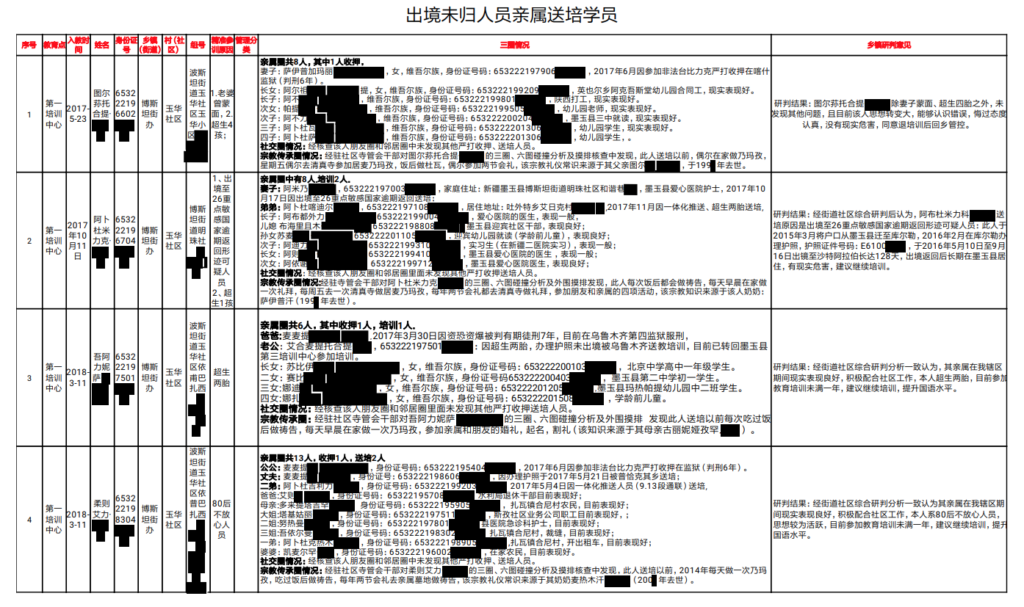
The Qaraqash Document, titled “Internees related to ‘unreturned’ persons” (出境未归人员亲属送培学员), is a spreadsheet containing detailed information in Mandarin about the family, social, and religious circles of a subset of detainees from throughout Qaraqash county, all of whom are 1) related to at least one person who is outside China and 2) under the jurisdiction of eight neighborhood offices in the Bostan subdistrict. UHRP obtained the document from Uyghur exile Abduweli Ayup, who received the document from Asiye Abdulaheb after a government employee in the Uyghur region leaked it to her. The document presents data on internees and the members of their familial, social, and religious circles through information detailed in a series of cells including the following:
- Entry numbers. Each entry begins with a unique number in numerical order between 1 and 667.Many internees have repeat entries in the document, meaning that the total number of internees listed in the document, 311, is lower than 667.
- Facility of detention. The document refers to four detention centers: the No. 1 Training Center (第一培训中心), No. 2 Training Center (第二培训中心), No. 3 Training Center (第三培训中心), and No. 4 Training Center (第四培训中心). The document also lists a “health-care area”(医护区); it is unclear whether this area is located at one of the camps or is a separate facility in its own right.
- Date interned. The document lists some (but not all) internees’ dates of internment. The entries stretch from April and May 2017 to October 28, 2018, suggesting that the document could be dated to late 2018 or early 2019. We know that the document incorporates periodic new information on old cases, but the latest date which appears in the document is March 8, 2019,meaning either that it was obtained and leaked at that time or that there were simply no more versions of the document after this date.
- Internee name. This cell lists each internee’s first and last names, transliterated into Chinese characters.
- ID number. This cell lists each internee’s 18-digit Chinese national ID number. All IDs begin with 653222, signifying a household registration in Qaraqash county.
- Responsible subdistrict office. Each internee listed in the document falls under the administration of the Bostan subdistrict office. (We describe the demographic makeup and administrative structure of Bostan, one of four Qaraqash subdistricts, in greater detail in the following section.)
- Responsible neighborhood office. This cell notes the neighborhood (and related administrative office) responsible for each internee. All eight neighborhoods in Bostan subdistrict (detailed below) appear throughout the spreadsheet.
- Internee address. These addresses are likely those noted in each internee’s household registration.
- Reason(s) for detention. Information in this column records the reason(s) for each internee’s detention. (We describe reasons for detention in further detail in Section IV.)
- Management level. A number of entries include notes about the “management level” of internees, including “normal” (普), “strict” (严), or “maximum” (强) management.
- “Three circles.” This is the most extensive column of the document. In it, the compilers have recorded detailed information about individuals connected to detainees in three categories: 1)immediate and extended family, 2) friends and neighbors, and 3) religious circle. Entries in this column include detailed information about the associated individuals, such as name, ethnic group, sex, ID number, age, employment place/status, and behavior status (e.g., “good behavior,” “ok behavior,” etc.). Other information included in some but not all entries includes detention status and any relevant prior criminal charges and/or sentence lengths. Many entries make note of the use of what we have translated as “three circles and six diagrams collision analysis” (三圈六图碰撞分析), which appears to be a method authorities are using to gather and analyze data. This “three circles and six diagrams collision analysis” appears to be a novel term that warrants future investigation and scrutiny.
- Evaluation. This column notes whether a particular internee should remain in internment or be released. In several cases, the evaluation appears not in the evaluation column but instead in the “three circles” column.
The identities of the government employees who compiled the information and created the document are not recorded. However, language in the document, including phrases such as “neighborhood office opinion” (社区意见), suggests that its provenance is the Bostan subdistrict office and the eight neighborhood offices (社区) under its administration.

III. The State Administrative Apparatus in Bostan, Qaraqash
This document shines important light on the administrative apparatus of extrajudicial and indeed extralegal internment in Bostan, Qaraqash, as well as in the Uyghur region more broadly. Qaraqash county (Uy. Qaraqash nahiyesi, Ch. 墨玉县) is located in the northwest part of Hotan prefecture. The center of Qaraqash, which is one of seven Hotan counties, is located roughly 21 miles (34 kilometers) from Hotan city, the administrative center of the prefecture. Statistics from 2018 list the 2017 population of Qaraqash as 646,202 individuals, 97.73% (or 631,541) of whom were Uyghur and 2.22% (or 14,392) of whom were Han.2Members of the Hui, Mongolian, Manchu Kazakh, Kirgiz, Xibe, Uzbek, and other groups comprised the remaining .05% of the population that year. The population of Qaraqash grew 12% between 2015 and 2017, and the Uyghur population of the county had the largest growth in that period, from 563,606 in 2015 to 631,541 in 2017.3新疆统计年鉴 2018 [2018 Xinjiang Statistical Yearbook]. (2018).4 Statistics published on the website of the People’s Government of Qaraqash County in February 2018 list the 2015 population of Qaraqash as 577,391 individuals, 97.61% (or 563,606) of whom were Uyghur and 2.34% (or 13,522) of whom were Han. Members of the Hui, Mongol, Manchu, Kazakh, and other ethnic groups accounted for the remaining 0.05% of the Qaraqash population as of the same year. 电子政务办公室. (2018). 人口 民族 [Ethnic Population]. [online] 墨玉县人民政府. Available at: http://www.myx.gov.cn/cms/index.php?m=content&a=index&classid=237&id=2546.
The Bostan subdistrict is centered on an area in the northeastern corner of the Qaraqash administrative center. In Chinese administrative governance, a subdistrict (街道) is a political administrative designation given to township-size units attached to a larger urban area, as opposed to discrete townships or towns. Each subdistrict has its own bureaucratic management office, which is often rendered in English as the “subdistrict office” (街道办 or 街道办事处). A single subdistrict such as Bostan consists of multiple smaller neighborhood units known as shequs (社区), which are managed by offices referred to colloquially by the same name.5 Shequs date to the 1990s, an experiment in restructuring the bureaucratic relationship between government and citizenry following the breakup of the work-unit system of social organization across the PRC. For more on the role of shequs in the Uyghur region, and particularly for an ethnographically based discussion of the shequ’s role in perpetrating forms of confusion and state violence against Uyghur citizens, see geographer Sarah Tynen’s (2019) “State territorialization through shequ community centres: bureaucratic confusion in Xinjiang, China” (unpublished Ph.D. dissertation) https://rsa.tandfonline.com/doi/abs/10.1080/21622671.2019.1643778#.Xh9-u1NKhm8. Bostan includes eight such neighborhoods: Umid (希望), Yipbazar (依甫巴扎), Yuhua (玉华), Shadliq (夏特勒克), Bostan (波斯坦), Yengisheher (英协海尔), Yuhe (玉河 ), and Üzüm (玉祖木).
Publicly available government sources show that changes to the administrative structure of Qaraqash occurred in 2017. In May of that year, the Qaraqash County Party Committee established four new district management committees (区管委会), numbered 1 through 4, to oversee the work of the Chinibagh (其乃巴格街道), Siza (斯孜街道), Bostan (波斯坦街道), and urban (城区) subdistricts.6电子政务办公室. (2020). 墨玉县历史沿革 [History of Qaraqash County]. [online] 墨玉县人民政府. Available at: http://www.myx.gov.cn/cms/index.php?m=content&a=index&classid=234&id=2533. In June and July 2017, the county party committee further created other district management committees, all overseeing a number of smaller administrative-political units throughout the county. That an administrative restructuring in Qaraqash occurred as the camp system expanded in earnest in 2017 is likely no coincidence. Rather, we believe it is further evidence to suggest that XUAR authorities, as well as government and Party officials reaching up to the highest levels of governance in the People’s Republic of China (PRC), have conceived of their campaign as one that encompasses the entire means of governance and social order in the Uyghur region. The extent to which this restructuring has occurred in other counties and administrative units throughout the region, as well as across the PRC more broadly, warrants future research.

IV. The Document in Numbers
The Qaraqash Document consists of 667 entries describing 311 individuals. While the document describes some individuals in only one entry, it describes others in as many as six. These multiple entries appear to have been written over a period of time, documenting multiple assessments of the behavior and attitudes of the internee and their family members in order to determine whether they should remain in re-education.
It is not possible to determine how large a sample of internees from Qaraqash county this document represents, but analyzing the demographic characteristics and reasons for their internment provides valuable insights into the nature of the internment campaign. Furthermore, the document provides additional solid evidence for many of the previously reported features of the ongoing crackdown in East Turkistan.
Demographic Characteristics: Age and Sex
One of the most striking aspects of the data is that internees are overwhelmingly male, with only 29 women identified among the 311 individuals. Most of the first-person survivor testimonies from former camp internees have been given by Uyghur and Kazakh women, some of whom were allowed to leave China due to marriage to a foreign national. However, this document is additional evidence suggesting that men are far more likely to be sent to the camps. Adrian Zenz has argued that the camps represent only part of a comprehensive program of controlling and reprogramming the Uyghur population, and that women are more likely to be sent directly into coerced labor in factories, bypassing the camps.7Zenz, A. (2019). Beyond the Camps: Beijing’s Long-Term Scheme of Coercive Labor, Poverty Alleviation and Social Control in Xinjiang. Journal of Political Risk, Vol. 7, No. 12 [online] Available at: https://doi.org/10.31235/osf.io/8tsk
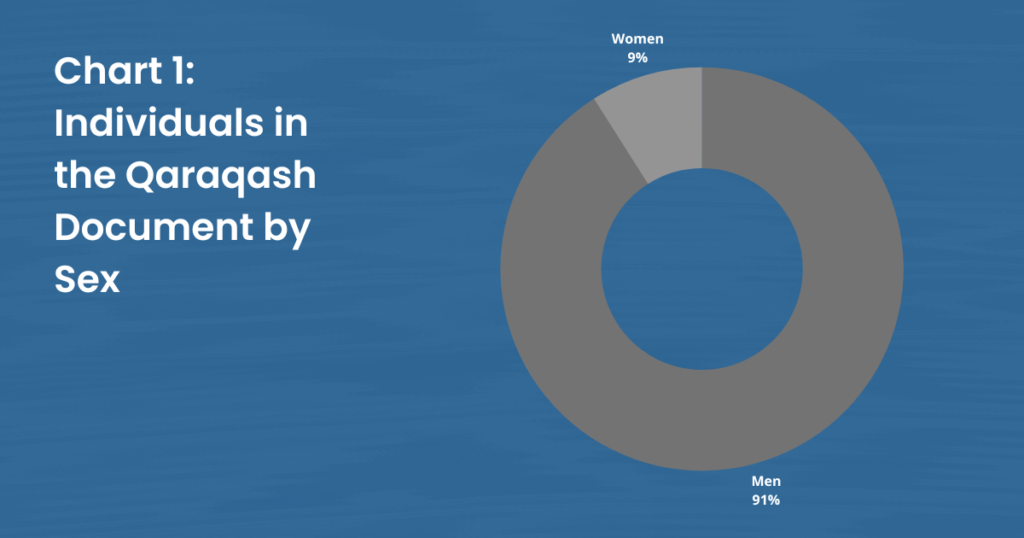
The age of the detainees skews towards the young and middle-aged; as can be seen in Table 1 below, being an “unsafe post ‘80s,’90s or ‘00s person” is one of the most common reasons for internment.
The Camps
The individuals in the document were sent to four different facilities. In many entries the facilities are referred to simply as Centers 1 to 4, while in others they appear with longer names which give additional information about their location. These names are Number One Training Center (Bostan)(第一培训中心[博斯坦库勒]), Number Two Training Center (Train Station) (第二培训中心[火车站]), Number Three Training Center (Old Vocational High School) (第三培训中心[老职高]), and Number Four Training Center (Number Two Middle School) (第四培训中心[二高]). References to other detention centers appear in the “three circles” column. In some entries the individual’s relatives are listed as teachers or detainees in district or area training centers (区培训中心), including district centers number 6, 10 and 12. Several individuals are described as being in a medical facility, and some appear to have been moved between facilities. The detainees were overwhelmingly sent to Center One and Center Two. Center One is a facility constructed for the purpose of serving as an internment camp and located in the southwest corner of Qaraqash county. There is a train station located in the county, but it is not certain where the camp is located.
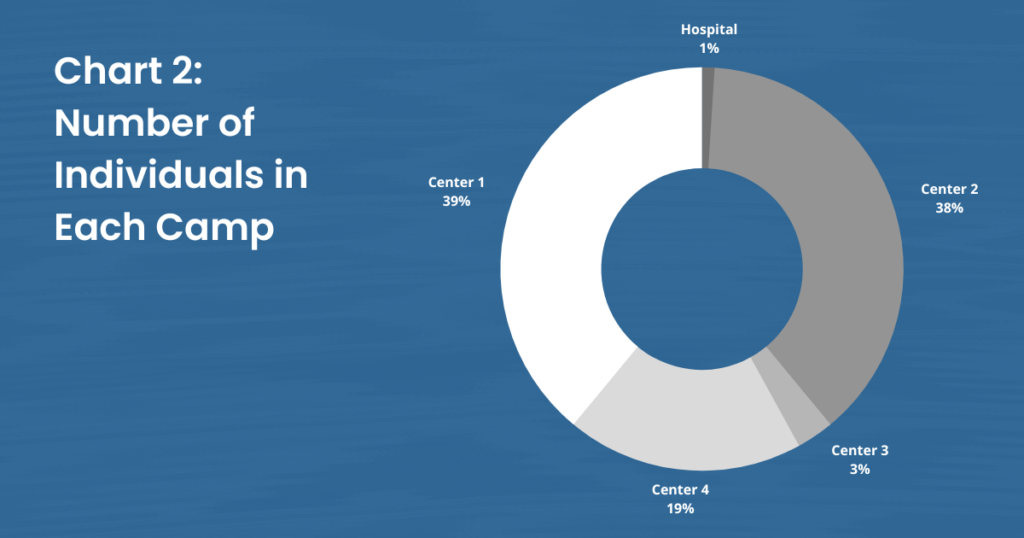
Satellite Images of Identified Camps in Qaraqash County:
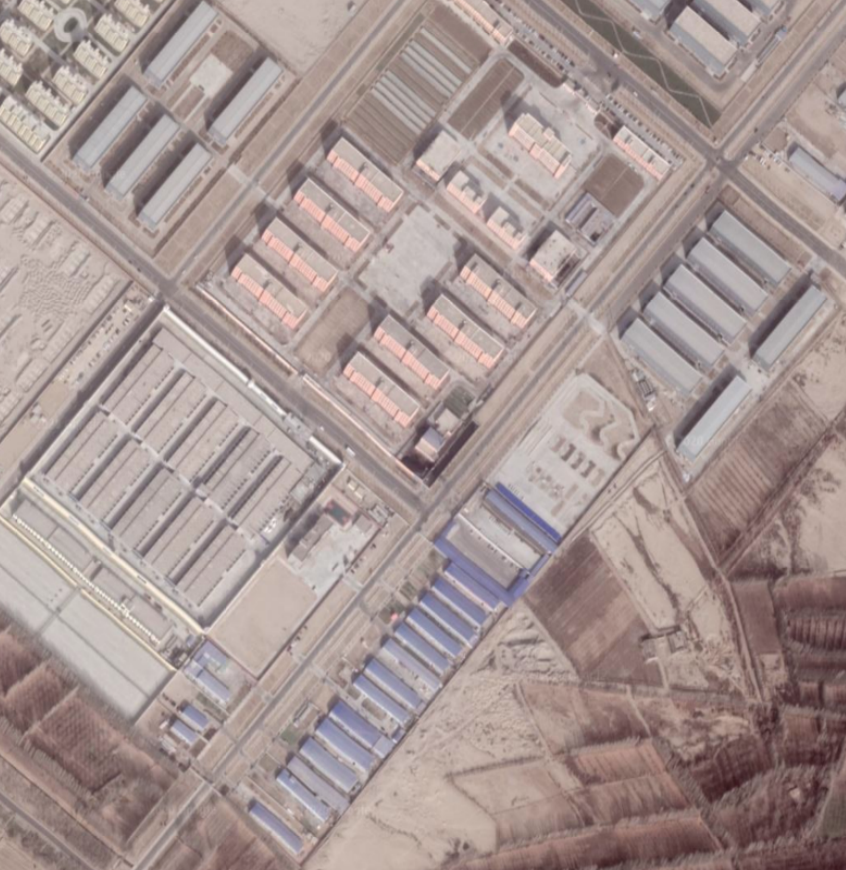
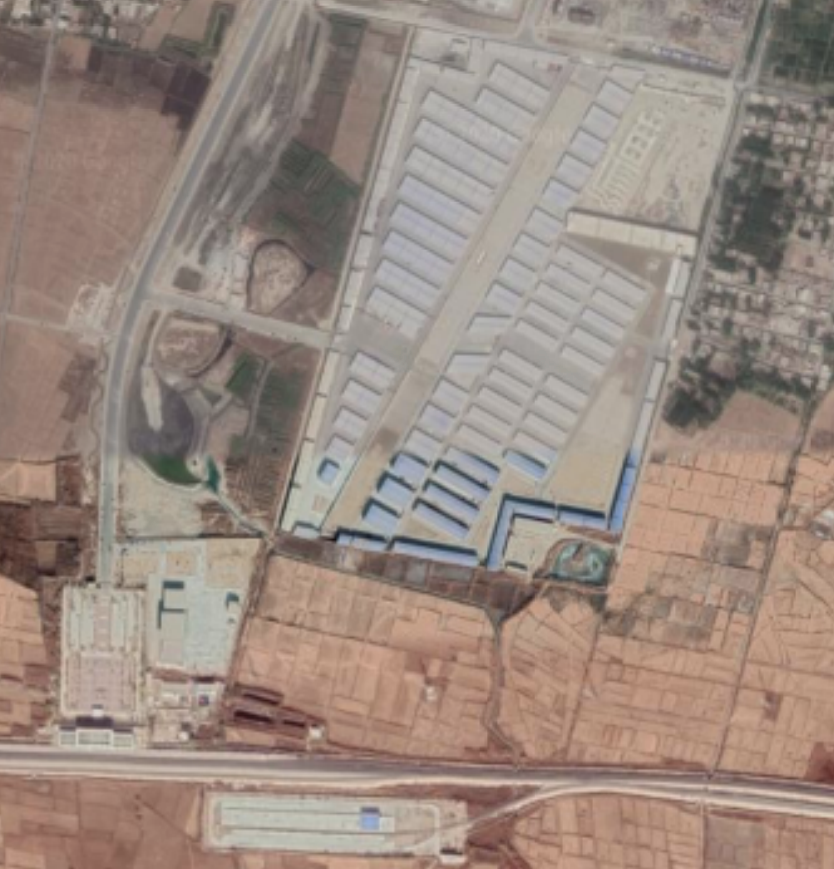
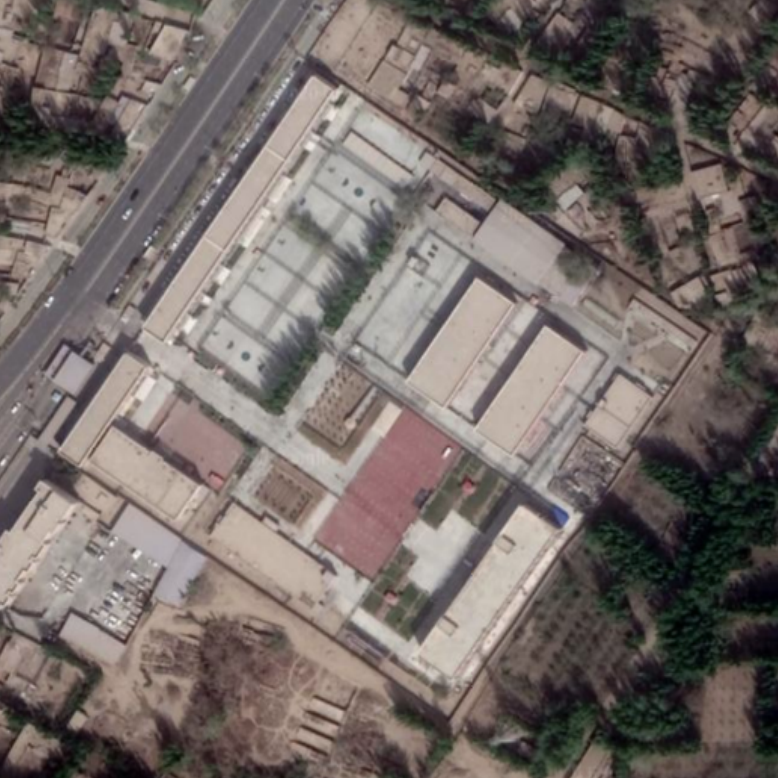
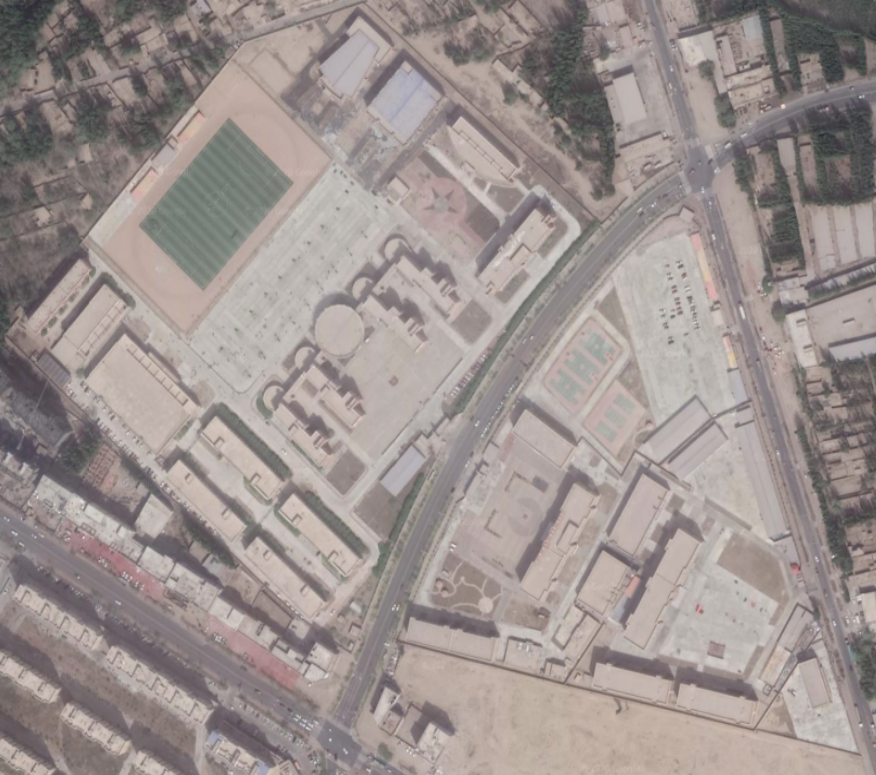
Reasons For Detention
The Qaraqash Document is a list of people in the “re-education” system who have relatives overseas, suggesting that overseas relatives are a major reason for suspicion by the government. However, only a small number of entries in the document list overseas relatives as a reason for internment. The numerous other reasons listed in the “reasons” column provide evidence of why the government is sending people to internment. While the language in the document is fairly standardized, in some cases the compilers have used a variety of terms to describe similar reasons. We have grouped those reasons together and listed them below. Some individuals in the document have only one reason for detention listed, while others have multiple reasons, meaning the total number of reasons is higher than the number of individuals described. For a detailed breakdown of the reasons for internment listed in the document, please see Appendix II.
| Reason | Number |
| Birth policy violations | 115 |
| Unsafe post 80s, 90s, or 00s person | 91 |
| Ex-convict or other past law violation | 40 |
| Wore veil/wife wore veil/had beard | 33 |
| Applied for passport (and didn’t leave the country) | 25 |
| Reason related to religious practice | 23 |
| International travel | 20 |
| Religious extremist thought infection | 19 |
| Related to prisoner | 12 |
| Movements within China | 8 |
| Possessed or watched illegal media | 5 |
| Two-faced official | 5 |
| Related to someone outside of the country | 4 |
| Did not obey shequ personnel | 4 |
| Fraudulent marriage certificate | 3 |
| Overseas communication | 2 |
Table 1: Reasons for Internment
Family-planning policy violations are the single most common reason for internment in the Qaraqash Document. The document lists the number of excess births each individual is responsible for, also making note when a single birth resulted in more than one child. Uyghurs in the document are sent away for one or more extra births; in one case simply disobeying the birth spacing policy, requiring three years between births, is listed as a reason. Another lists obtaining a “false abortion certificate” as a reason in addition to extra births. Some individuals are described as “maliciously” violating birth policies (恶意超生) if they have a large number of children. However, it is not clear that the consequences for one extra birth are any lighter than the consequences for more than one extra birth.
Notably, men constitute the majority of those who were interned for violating birth policies. Inmost of these cases, the description in the “three circles” section seems to suggest that the men’s wives were not interned for the same reason. That family-planning policy violations constitute the primary reason for internment in the Qaraqash Document is intriguing. It might simply be the case that officials looking to meet internment quotas were searching for any legal or other violation among the Uyghur population in Qaraqash, where anecdotal evidence suggests that Uyghur birthrates have long been high. However, it is also possible that these internments are consistent with state anxieties about the demographic make-up of the Uyghur region. The internment campaign has been preventing the formation of new Uyghur families through physical separation of married couples and removal of people of child-bearing years into camps since 2017. The Qaraqash Document demonstrates for the first time that the campaign is also punishing those with large families.
Overseas connections appear in the Qaraqash Document as another major reason for internment. The document itself was compiled to list those with family overseas. Additionally, many entries list travel overseas as a reason for internment, sometimes specified as travel to one or more of 26“sensitive countries,” mostly Muslim-majority nations such as neighboring Central Asian states, Malaysia, Indonesia, and a number of African countries, among others.8Human Rights Watch. (2018). “Eradicating Ideological Viruses:” China’s Campaign of Repression Against Xinjiang’s Muslims. [online] Available at: https://www.hrw.org/report/2018/09/09/eradicating-ideological-viruses/chinas-campaign-repression-against-xinjiangs Saudi Arabia is on the sensitive countries list, but having been on an unofficial Hajj is often listed separately as a reason for internment. Applying for a passport is also a frequent reason for detention, even in cases when someone has never left the country. Many individuals appear to have been interned for merely applying for a passport in 2015, when Uyghurs were briefly encouraged by the government to do so. This brief campaign to encourage Uyghurs to apply for passports, following on a period of many years when passports were very difficult to obtain, has raised a question that remains unanswered. Analysts remain uncertain, raising the possibility that the government supported Uyghurs’ passport applications because it was deliberately seeking to identify Uyghurs who had a desire to travel.
Communicating with someone outside of the county also appears as a reason for detention in the spreadsheet. One individual was sent for “accidentally clicking on an overseas website on their phone” (手机点击网站链接无意登陆境外网站). Individuals who traveled domestically were targeted, underscoring policies with the intent of controlling Uyghur movements within China as well. The document lists several individuals who were interned for “complex” movements and communication (外出期间人际交往和活动轨迹比较复杂). The precise meaning of this term is unclear; however, it illustrates that Uyghurs cannot move freely around China without suspicion. Others are specifically labeled “7.5 diverted persons” (7.5 分流人员), referring to Uyghurs who were expelled from the regional capital of Urumchi following the July 5, 2010 riots and who remained on the radar of the authorities afterward.
Violations involving religious practice are another major reason for internment. Going on a Hajj not organized by the government is an additional violation beyond just visiting Saudi Arabia. Wearing a veil, having a wife who wore a veil, or having a beard are among the reasons for internment. Some individuals were sent for participating in any unofficial religious activities, studying religion, or even having a household with a “dense religious atmosphere” (家庭宗教氛围浓厚). The data clearly demonstrates that eliminating religious practice is one of the central goals of the re-education campaign.
Shequ Assessment and Current Status of Internees
The entries in the document give a sampling of the process of internment for the people of Qaraqash county. It is not possible to determine whether the fact that some individuals have multiple entries, and others only one, indicates something about their ultimate fate or whether it is simply due to a sampling bias in the document.
| Judgment in final entries | No. of individuals |
| Community management and control | 98 |
| Finished/safe | 77 |
| Continue training, finish after one year | 43 |
| Working at the park (在园区就业) | 41 |
| Continue training | 34 |
| Returned for work (返乡就业 / 返回就业) | 11 |
| Official returned to post, continued management | 2 |
| At Hotan Vocational School | 2 |
| Sentenced to prison (strike hard) | 2 |
| Can have regular home visits (正常回家探亲) | 1 |
Table 2: Assessment of the Shequ in the Last Entries of Each Individual
While numerous entries indicate that a particular individual is no longer in “training,” it also appears that this does not necessarily mean that they have been released. Many entries describe individuals as being returned to their residence for local monitoring under “shequ management and control” (社区管理管控), while others describe them as “found employment.” The term used, jiuye (就业) can have the innocuous meaning of simply getting a job, but it is also associated with China’s longstanding “re-education through labor” or laogai (劳改) system, describing people being released from a re-education camp or prison into a factory or other facility where they work with little or no pay and remain under state monitoring and control.9Seymour, J. and Anderson, M. (2015). New Ghosts, Old Ghosts: Prisons and Labor Reform Camps in China. Routledge. This term is used extensively in the many categories of forced labor and forced-work-placement implemented intensively by Xinjiang authorities since mid-2018.10Zenz, A. (2019). Beyond the Camps: Beijing’s Long-Term Scheme of Coercive Labor, Poverty Alleviation and Social Control in Xinjiang. Journal of Political Risk, Vol. 7, No. 12 [online] Available at: https://doi.org/10.31235/osf.io/8tsk2
Only a small number of entries specify the job the individual is engaged in. For example, Entry484 describes the internee as running his family’s curtain shop, and Entry 592 notes that the internee is a janitor in a kindergarten. The standardized language in the remainder of the entries may indicate placement in a coerced labor program. Some official media reports from the region describe Uyghurs being sent to job placement far from their homes,111 和田日报. (2019). 墨玉县实现城乡富余劳动力转移就业 17.91 万人次 [Qaraqash County Conducted 179,910 Transfers of Surplus Rural Labor to Employment.] [online] Available at: https://news.sina.cn/gn/2019-11-12/detail-iihnzahi0371131.d.html which appears to be a method of both maintaining control over the population and weakening their connection to their culture, as described in recently published analyses.12Lehr, Amy and Bechrakis, Efthimia Maria. (2019). Connecting the Dots in Xinjiang: Forced Labor, Forced Assimilation, and Western Supply Chains. CSIS. [online] Available at: https://csis-prod.s3.amazonaws.com/s3fs-public/publication/Lehr_ConnectingDotsXinjiang_interior_v3_FULL_WEB.pdf One report from Qaraqash county shows the local Party Secretary giving a speech to Uyghurs being sent to employers “inside and outside Xinjiang,” telling them that they must “listen to their team cadres, obey management, work hard no matter the time or place, not participate in illegal religious activities and criminal activities.”13和田零距離 發表于社會. (2017). 墨玉縣勞務輸出實現開門紅 970 名務工人員邁上打工之旅 [Qaraqash County’s Labor Export Has a Good Start. 970 Migrant Workers and Their Journey to Work.] [online] 每日頭條. Available at: https://kknews.cc/society/k86ng2q.html.
There are also numerous entries which list the individuals as being sent to “work in the industrial park” (园区就业). These seem even more likely to be reference to forced labor, given the testimonies of forced labor in factories that have emerged from the region.14McNeill, Sophie, McGregor, Jeanavive, Griffiths, Meredith, Walsh, Michael, Hui, Echo, Xiao, Bang. July 2019. Cotton On and Target investigate suppliers after forced labour of Uyghurs exposed in China’s Xinjiang. ABC Four Corners. [online] Available at: https://www.abc.net.au/news/2019-07-15/uyghur-forced-labour-xinjiang-china/11298750 In some entries, such as Entry 227, the shequ officials agree to send the individual to “work in the industrial park” but do not agree to “finish,” clearly showing that detainees are being sent to work while still in the reeducation program. In 2018, Shawn Zhang identified the largest camp in Qaraqash county, referred to in the Document as the “Number 1 Training Center,” or sometimes as the “Number One Training Center (Bostan).” He notes that “[B]ostan” refers to the industrial park in the facility, with the re-education camp located in the southeast corner of the compound.15Zhang, S. (2017). Satellite Imagery of Xinjiang “Re-education Camp” №7. [online] Medium. Available at: https://tinyurl.com/r2zkcuy. Several entries describe individuals as sent to the Hotan Vocational School after finishing re-education; it is not clear if this is part of the camps system or a genuine vocational school.
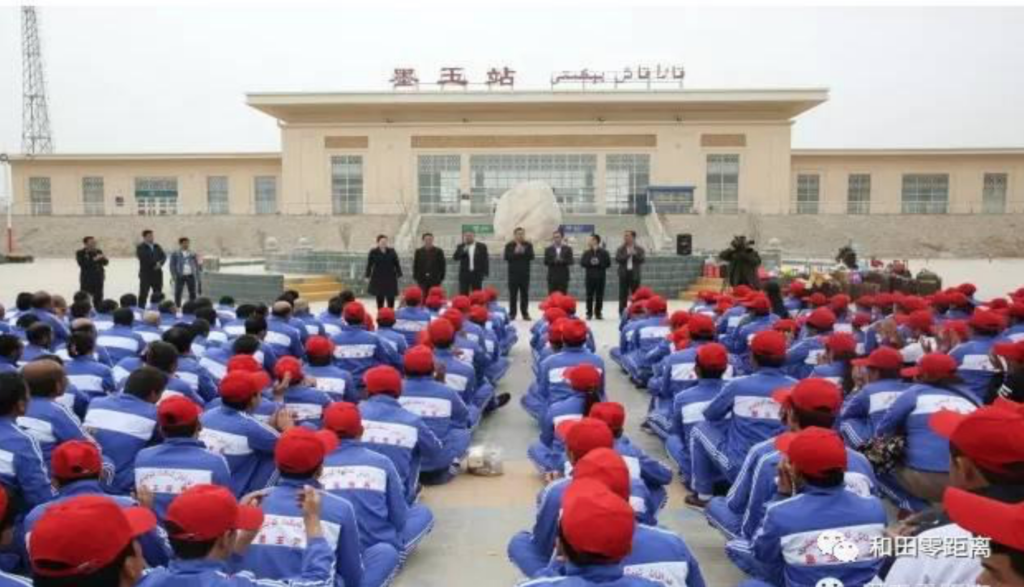
The document reveals details about what has been happening in Uyghur towns and villages during the internment campaign. Shequ officials assess the behavior and attitudes of detainees’ relatives, including their participation in “shequ work” (社区工作). The “good behavior” of their relatives appears to be a key determinant of whether a detainee will be released. Officials enter Uyghur households to carry out these political and behavioral assessments. Entry 369, for example, describes community officials coming to the home of the detainee’s wife and being told by her son that she was not at home, raising suspicions that she was deliberately avoiding them and obstructing their work. Entry 315 describes the family members of the detainee blocking the door to prevent officials from entering the household.
Detainees and their relatives continue to be assessed after being released from the camps into shequ “management,” where they and their family members continue to be subjected to bureaucratic control. Shequ officials assess and record whether former internees’ moods and thinking are “stable” (思想/情绪稳定), determining whether they “can recognize their mistakes” (能够认识错误), have a “sincere attitude of regret” (悔过态度认真), and/or “present no threat” (没有现实危害).
Disobeying village management personnel and failing to participate in “community work” are also among the reasons for being sent to a camp, demonstrating the compulsory nature of these activities. One individual (Entry 309) was sent for not cooperating with the shequ work, including not joining flag raisings and not carrying out patrol duty. Entry 378 notes that the detainee’s family members occasionally fail to join flag-raising ceremonies on time, and recommends that the detainee should not be released. Other entries describe cooperating with community work such as participating in propaganda rallies (发声亮剑活动), complying with the attendance system (考勤制度), and attending shequ-organized concentrated study and speech activities (集中学习和宣讲活动). Some individuals released from detention are noted as having daily visits from local cadres, signing in every morning and attending roll call after work.
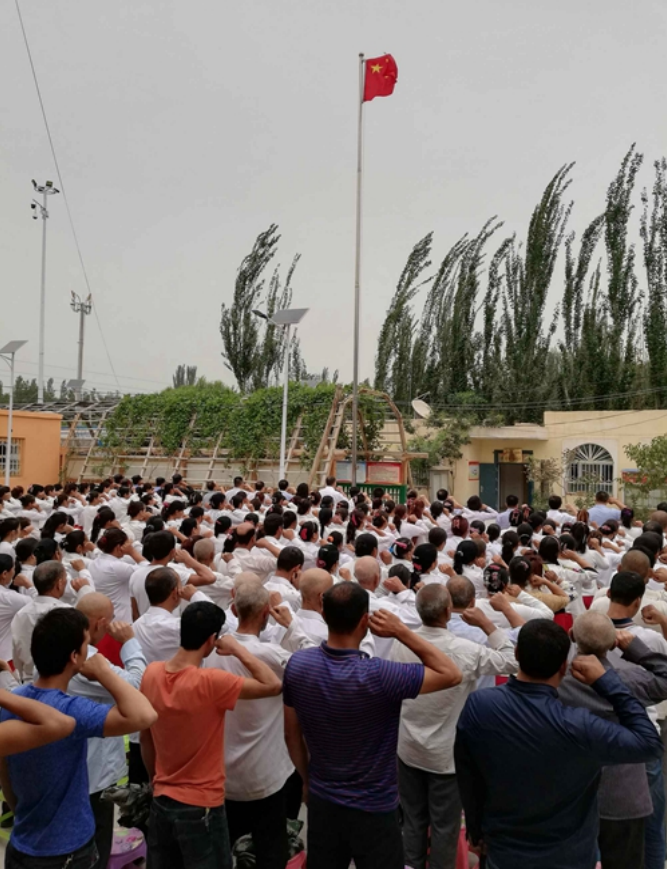
工作总目标的重大责任. [Xinjiang Branch: Emphasize political construction, keep in mind the original
mission, bravely bear the duty of the overall goal of Xinjiang work] [online] Available at:
http://www.cas.cn/zt/rwzt/ysyrys/sjfbb/201810/t20181023_4667180.shtml

V. The Document in the Context of State Policies
The ground-level information contained the Qaraqash Document confirms policy measures put in place from 2017 into the present, laying bare the technological and human resources required to implement mass scale repression. The Qaraqash Document provides for the first time a direct link between the leaked policy documents published by the New York Times and the ICIJ, and ground level experiences of targeted Uyghurs and other Turkic peoples, as revealed by the testimony of survivors and family members of residents.
The Integrated Joint Operations Platform
The document provides a stunningly detailed example of the results generated by the surveillance and data-collection system used by Xinjiang authorities, the Integrated Joint Operations Platform, or IJOP (一体化联合作战平台). In May 2019, Human Rights Watch released “China’s Algorithms of Repression,” a report detailing a cell-phone app that Chinese police and officials utilize to connect to the IJOP. It collects a vast array of microdata, including such details as electricity use and ownership of exercise equipment, to build a composite picture of individuals. The collated information is leveraged to determine people considered as threats to the state and as a result who should be detained and interned.
The platform integrates information on numerous legitimate activities labelled by authorities as suspicious, including lack of socialization and use of everyday communications tools, such as WhatsApp. Peaceful expressions of religious belief and practice also indicate unsuitable behavior. Human Rights Watch’s report notes: “Another key element of IJOP system is the monitoring of personal relationships. . . . For example, the IJOP app instructs officers to investigate people who are related to people who have obtained a new phone number or who have foreign links.”17Wang, M. (2019). China’s Algorithm of Repression. [online] Human Rights Watch. Available at:
https://www.hrw.org/report/2019/05/01/chinas-algorithms-repression/reverse-engineering-xinjiangpolice-mass-surveillance When Chinese state representatives visit Uyghur and other Turkic peoples’ homes to gather this data, there is no requirement to inform individuals as to the reason for the collection of details on the minutest aspects of their lives. However, as Human Rights Watch states, it is “consistent with Xinjiang local government statements that emphasize officials must collect data for the IJOP system in a ‘comprehensive manner’ from ‘everyone in every household.’” In November 2019,the International Consortium of Journalists revealed government records showing that more than15,000 individuals were detained in a seven-day period as a result of being identified as suspicious by the IJOP.18Allen-Ebrahimian, B. (2019). Exposed: China’s Operating Manuals for Mass Internment and Arrest by Algorithm. [online] International Consortium of Investigative Journalists. Available at: https://www.icij.org/investigations/china-cables/exposed-chinas-operating-manuals-for-mass-internmentand-arrest-by-algorithm/. As such, the implementation of the IJOP demonstrates little to no relationship with the Chinese government’s stated goal of conducting counterterrorism actions.
The Qaraqash Document mentions the IJOP system at several points in the “Three Circles” column, emphasizing how suspicion is established through “guilt by association.” For example, relatives of the people in Entry 2 and Entry 4 were sent to re-education centers based on information gathered by the IJOP, as was Entry 19’s brother, a small-business owner, who was interned on October 2, 2017. The individual in Entry 13 was referred to state authorities based on information collected in the IJOP and was not sent to an internment camp after her employer vouched for her character. A neighbor of the individual in Entry 14 was not as fortunate, however, and was interned from February 2018. The IJOP identified the person as living or traveling with high-risk individuals. In the “Evaluation” column, the Qaraqash Document notes the discovery that the individual in Entry 50 was friends via WeChat with a suspicious Uyghur based in Turkey. Under interrogation, he denied the link, and the authorities concluded to continue his internment. Entry221 shows the implications of religious associations and was interned on April 8, 2017 for traveling and living with a “wild imam” (野阿訇). The internment was concluded on August 24, 2018.
References to the kinds of suspicious behavior identified in the IJOP app occur throughout the Qaraqash Document. As described in Entry 221, connections between Uyghurs and people and places overseas is cause for concern among Chinese officials. In an iterative pattern, Uyghurs are interned or imprisoned for “infractions” ranging from applying for a passport, even though the individual did not even go abroad, to traveling overseas.
For example:
Entry 2 (“Evaluation” column)
“From May 10 to September 2016, he visited Saudi Arabia for 128 days. Upon returning, he stayed long-term in Qaraqash county. He poses a threat and we recommend he continue his reeducation.”
Entry 20 (“Three Circles” column)
“…sentenced for 15 years in August 2017, for online contact overseas, now serving in the Urumchi Women’s Prison.”
Entry 31 (“Three Circles” column)
“His wife…was sent to a training center…because she went abroad. She finished training on July21, 2018. His brother…was sent to a training center because he visited Dubai.”
Entry 80 (“Reason(s) for detention” column)
“Visited sensitive countries four times to do business.”
Entry 114 (“Reason(s) for detention” column)
“Applied for passport.”
Entry 202 (“Reason sent for re-education” column)
“Went abroad for pilgrimage three times.”
Entry 207 (“Reason(s) for detention” column)
“Family member of runaway person (abroad).”
Another item of information communicated to the IJOP by local officials is any expression of religious belief and practice. Accounts from internment camp survivors and families of victims regularly cite religion as a primary reason for detention in the camp system.19Tursun, M. (2018). Hearing: The Communist Party’s Crackdown on Religion in China November 28,2018. [online] Congressional-Executive Commission on China. Available at: https://www.cecc.gov/sites/chinacommission.house.gov/files/documents/REVISED_Mihrigul%20Tursun%20Testimony%20for%20CECC%20Hearing%2011-28-18_0.pdf; Buckley, C. (2018). China Is Detaining Muslims in Vast Numbers. The Goal: ‘Transformation.’ [online] The New York Times. Available at: https://www.nytimes.com/2018/09/08/world/asia/china-uighur-muslim-detentioncamp.html; and Feng, E. (2019). ‘Illegal Superstition’: China Jails Muslims For Practicing Islam, Relatives Say. [online] NPR. Available at: https://www.npr.org/2019/10/08/764153179/china-has-begunmoving-xinjiang-muslim-detainees-to-formal-prisons-relatives-say. The Qaraqash Document once again confirms participation in religious activities and belief in Islam as a leading reason for internment or suspicion despite clear indications these practices are legitimate and peaceful. As noted above, 23 individuals were detained for their religious practice and another 19for “religious extremist thought infection.” Throughout the document individuals are highlighted as persons of interest due to their faith. The cases are too numerous to cite individually; however, two examples illustrate how the Chinese government violates the Uyghurs and other Turkic peoples’ fundamental human right to freedom of religion.
Entry 64 (“Three Circles”)
“Investigation conducted by local offices finds that this person has basic religious knowledge(prays, goes to religious events and ceremonies). His religious knowledge came from his grandfather and was received when he was a child. (Grandfather was sentenced for six years in June 2017 for inciting terrorism ideology).”
Entry 181 (“Three Circles”)
“This person undertook a pilgrimage to Arab [sic],20The reference likely means Saudi Arabia. went to a mosque during the two main religious holidays, prayed at home, attended religious events and ceremonies, prayed at home after meals, and fasted. His religious knowledge comes from his mother.”
“Becoming Family” Household Surveillance
The Qaraqash Document provides confirmation of the implementation of the Xinjiang “Becoming Family” program of intense monitoring inside Uyghurs’ homes. The “Becoming Family” policy sends Party cadres to regularly undertake multi-day “homestays” with Uyghur families. The government called the observers “big sisters or brothers,” echoing the exact language of early CCP development policies in East Turkistan that placed the Uyghur as a backward people in need of civilizing influences from more advanced societies. However, the intense repressive turn in the region means the current use of the term has taken on a more intimate form. “Big sisters and brothers” are cadres, predominantly Han, tasked with gauging the loyalty of Uyghurs. As the Human Rights Watch described the program: “During these visits, families are required to provide officials with information about their lives and political views, and are subjected to political indoctrination.”21Human Rights Watch (2018). China: Visiting Officials Occupy Homes in Muslim Region. [online] Human Rights Watch. Available at: https://www.hrw.org/news/2018/05/13/china-visiting-officialsoccupy-homes-muslim-region.
The “Becoming Family” policy limits remaining Uyghur spaces free from state intrusion and constitutes a gross violation of privacy. In an extended essay for ChinaFile, anthropologist Dr. Darren Byler detailed not only the presumption of Uyghur lip service to CCP fealty, but also the special emphasis placed on ordinary expressions of religious affinity that is built into the “Becoming Family” program:
“At times, the big brothers and sisters feared the Uighurs might be slippery, that however cheerfully they might open their houses or declare their loyalty to the Chinese nation, beneath their smiles and gestures of wholesome secularism there might lurk darker allegiances, uncured attachments to their “diseased” religious ways. But there were simple ways to test for this kind of thing. One could offer a host a cigarette or a sip of beer; a hand could be extended in greeting to a little sibling of the opposite gender, staying alert for signs of flinching. Or one could go out to the market for some freshly ground meat and propose that the family make dumplings. And then wait and watch to see if the Uighurs would ask what kind of meat was in the bag.”22Byler, D. (2018). China’s Government Has Ordered a Million Citizens to Occupy Uighur Homes. Here’s What They Think They’re Doing. [online] China File. Available at: http://www.chinafile.com/reporting-opinion/postcard/million-citizens-occupy-uighur-homes-xinjiang.
The Qaraqash Document confirms that information collected through the “Becoming Family” visits to Uyghur homes resulted in people being hauled away to camps. For example, Case 221 describes how one individual was flagged by a “big sister” or “brother” for merely wearing a headscarf. Camp survivor Zumrat Dawut confirmed the intrusiveness of the visits in an interview with Radio Free Asia: “The visitors will ask what family members have been doing recently, what food they cook, and even about their sleeping habits.”23Hoshur, S, Anderson, A, Lipes, J. (2019). Xinjiang ‘Pair Up’ Campaign Highlights Power Imbalance Between Chinese ‘Relatives,’ Uyghur Hosts. [online] Available at: https://www.rfa.org/english/news/uyghur/campaign-11192019152349.html. In its open abuse of privacy, the Chinese government undermines the fundamental right to freedom of religion through reporting of legitimate activities to the IJOP.
Rooting Out “Two-Faced” Officials
The appearance of the term “two-faced” in the Qaraqash Document also substantiates previous reporting on the varied strategies the state is employing to justify its repression of Uyghurs. Entry315 mentions the term and states that the individual was “taken in” for this reason. The term is usually leveled at Party members whom the authorities suspect of being disloyal to the state. UHRP’s October 2018 report “The Persecution of The Intellectuals in The Uyghur Region: Disappeared Forever?” describes several prominent Uyghur scholars who disappeared or censured on the charge.24Uyghur Human Rights Project (2019). The Persecution of The Intellectuals in The Uyghur Region: Disappeared Forever? [online] Uyghur Human Rights Project. Available at: https://uhrp.org/pressrelease/persecution-intellectuals-uyghur-region-disappeared-forever.html. In a report dated September 24, 2018, Radio Free Asia described how Azat Sultan, a literature professor at Xinjiang University, had been investigated for being a “two-faced” academic. 25Lipes, J. (2018). Uyghur Former Xinjiang University Vice President Detained For ‘Two-Faced’ Tendencies. [online] Radio Free Asia. Available at: https://www.rfa.org/english/news/uyghur/professor09242018164800.html. Abdukerim Rahman, a second literature professor at Xinjiang University, was similarly accused with the label. Amy Anderson, who knew Abdukerim personally, wrote: “it was hard to see the logic behind Rahman’s criminalization since his teaching and research had little todo with religion.…he had been accepted and celebrated by the Chinese party-state for over 50 years. How could a man be celebrated until the age of 77 and then suddenly be charged as a ‘twofaced’ person out of nowhere? Where is his second ‘face’?”26Anderson, A. (2018). How is Abdukerim Rahman surviving without his books? [online] Art of Life in Central Asia. Available at: https://livingotherwise.com/2018/10/02/abdukerim-rahman-surviving-withoutbooks/.
In sum, given the large number of relatives detailed, there is an inherent guilt by association outlined in the Qaraqash document. Every action, witting or unwitting, could endanger not only oneself but your family, relatives, any associate. This targeting of communities at the individual level reveals ingrained state paranoia and alarming intent. A process of suspicion, investigation, and punishment that is both perpetually capricious and violently disruptive to Uyghur lives.
Implications
The Qaraqash Document indicates the Chinese government is perfecting an art of repression that will not stop at East Turkistan. The possible export of this repression to the rest of China has already received extensive commentary. However, communication of the template that is contemporary East Turkistan to Beijing’s rising number of allies indicates the development of an anti-democratic bloc. Such a pattern has terminal implications for international human rights standards.
The Qaraqash Document details information only 311 individuals from Bostan subdistrict and other administrative units of Qaraqash, who were detained and then later reevaluated between early2017 and early 2019. UHRP suspects it is highly likely that more Bostan and Qaraqash residents than those listed in this document have been detained at one point or another from 2017 up to the time this list was generated. This conclusion is based on the suspicious behaviors described in the “Three Circles” column of the document, which extends to individuals beyond the 311 detainees. Furthermore, given the predominant Uyghur demographic in Qaraqash county and evidence that Uyghurs, regardless of status, have become state suspects means 311 individuals is the tip of the iceberg.
There are likely hundreds or thousands of similar documents generated by other subdistrict and neighborhood-level offices for other subsets of internees throughout the Uyghur region. Where are these other documents? International human rights standards and Chinese law do not allow for secret detention. The government must make public the complete list of all those in administrative detention or sentenced to a term of imprisonment and make information about their health and welfare available to family and lawyers.
Uyghurs by the million have lost their freedom and suffered countless acts of cruelty at the hands of the state. The scale of the human rights violations may never be countable. It is important to record and pay tribute to those individuals who are in the midst of an existential fight for their identity and culture. The contemporary breakup of Uyghur spaces under the Chinese Communist Party began in the 1990s with the demolition of cities and neighborhoods and the curbs placed on freedom to develop independent scientific, philosophical, and artistic works. We are now witnessing the dismantling of the smallest units of Uyghur society in family and personal relationships, a process evidenced in the Qaraqash Document. The document tells us the Chinese government is creating a new organization of Uyghur society: that of jailer and jailed, loyal and disloyal. This rearrangement constitutes a form of cultural genocide. The prevention of this cultural genocide is everyone’s responsibility.

VI. Methodology
This report presents a leaked official document from Qaraqash county, Hotan prefecture, East Turkistan. UHRP obtained the document from Uyghur exile Abduweli Ayup, who received the document directly from a government employee in the Uyghur region. The UHRP verified the authenticity of the document based on its similarity to other documents we have reviewed (but not published for safety reasons) in the past.
UHRP’s research team used publicly available information on the subdistrict to give context to the document’s data. The team cross-referenced names and ID numbers to determine the number of individuals represented in the document, and to trace and collate statistics about the camps where they were detained, the reasons they were detained and shequ officials’ judgments about detainees’ status.

VII. Acknowledgements
The research team at the Uyghur Human Rights Project (UHRP) wishes to express our thanks to all the individuals who contributed to this report. We are especially grateful to scholar and advocate Abduweli Ayup for entrusting us with the Qaraqash Document. Without his faith in our work, this report would not have come to fruition. We are also grateful to Dr. Adrian Zenz and Cheryl Yu at the Victims of Communism Memorial Foundation for their feedback on terminological and other questions, and to an anonymous translator for their fastidious work translating excerpts of the document. We would also like to thank UHRP Director Omer Kanat for his invaluable guidance and expertise, and UHRP Director of Global Advocacy Louisa Greve for her detailed feedback on early drafts. Finally, we express our deepest appreciation to the donors whose generous contributions to the UHRP make our research and reporting possible.
Appendix I
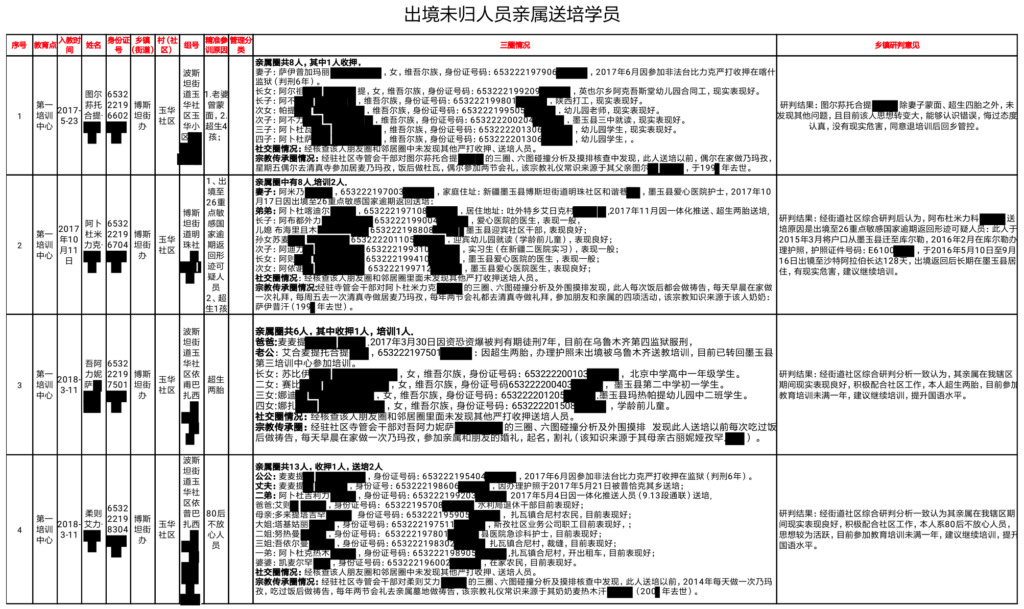
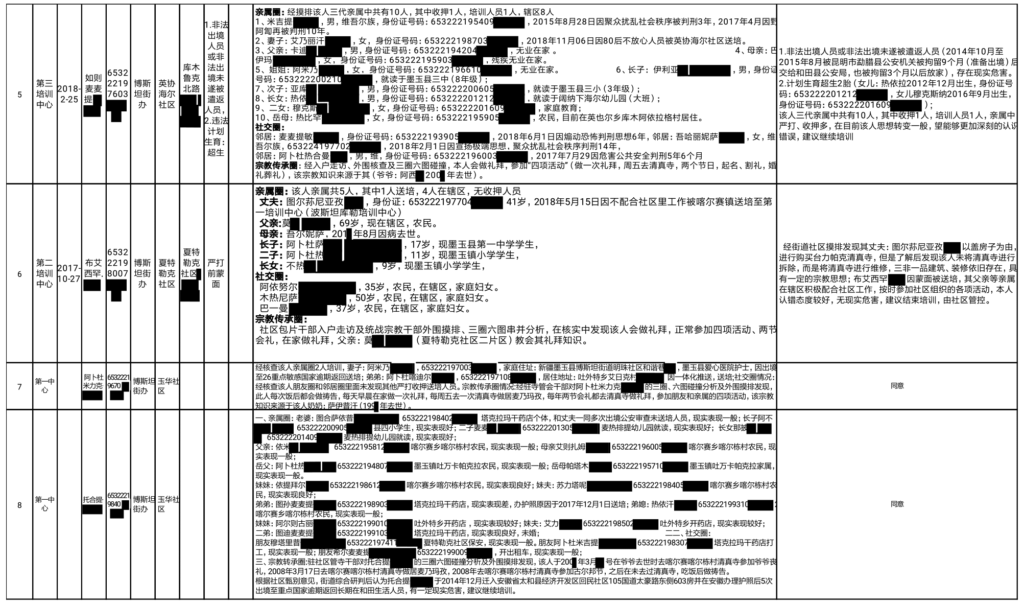
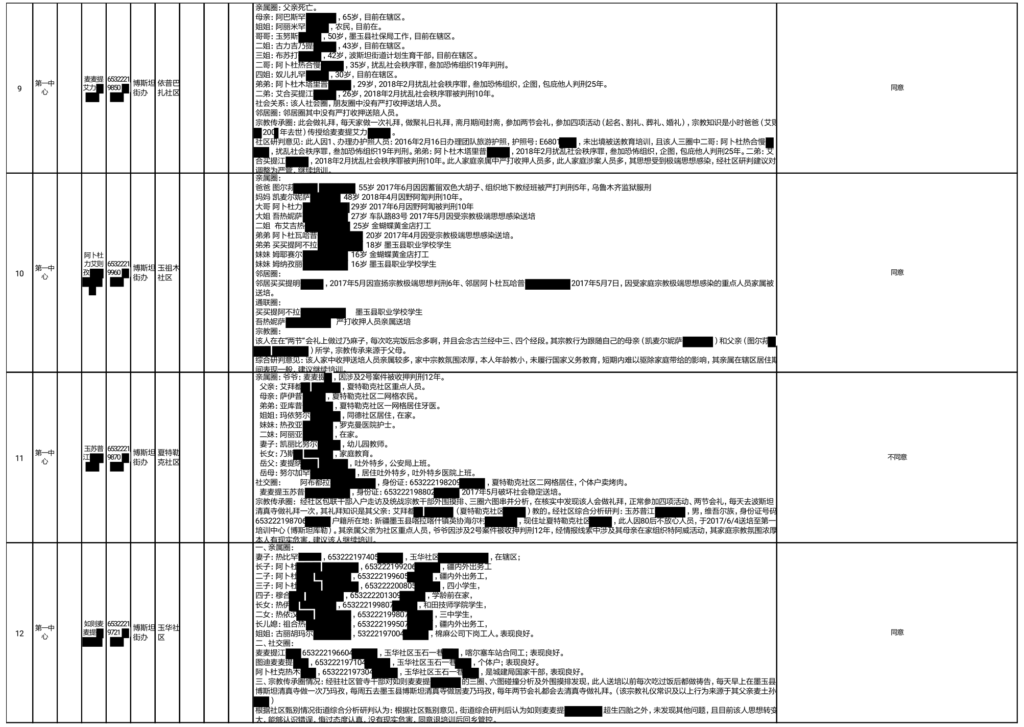
Appendix II
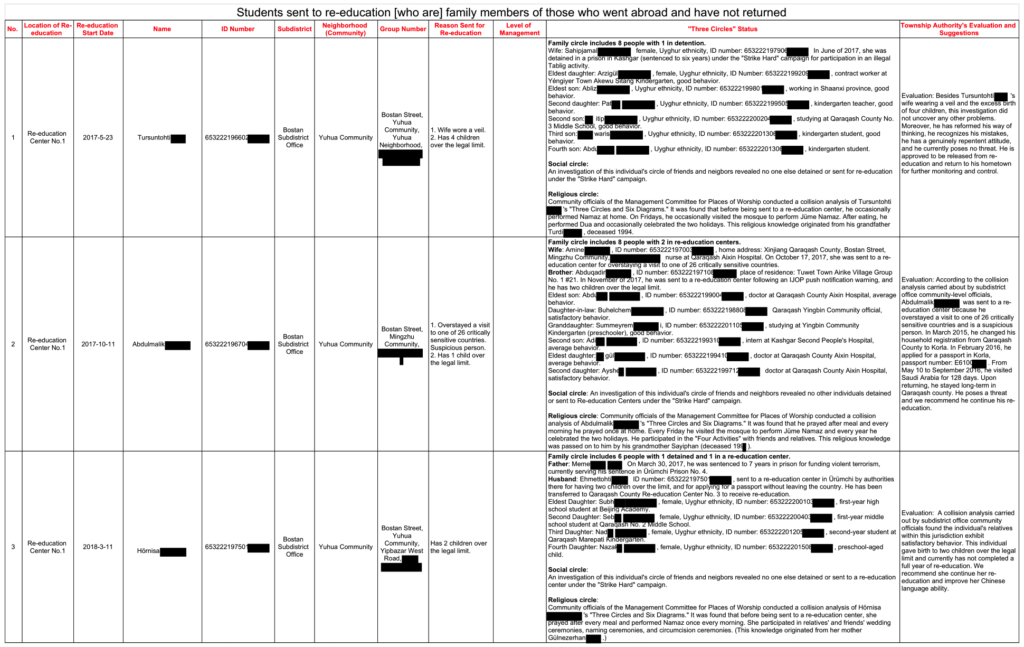
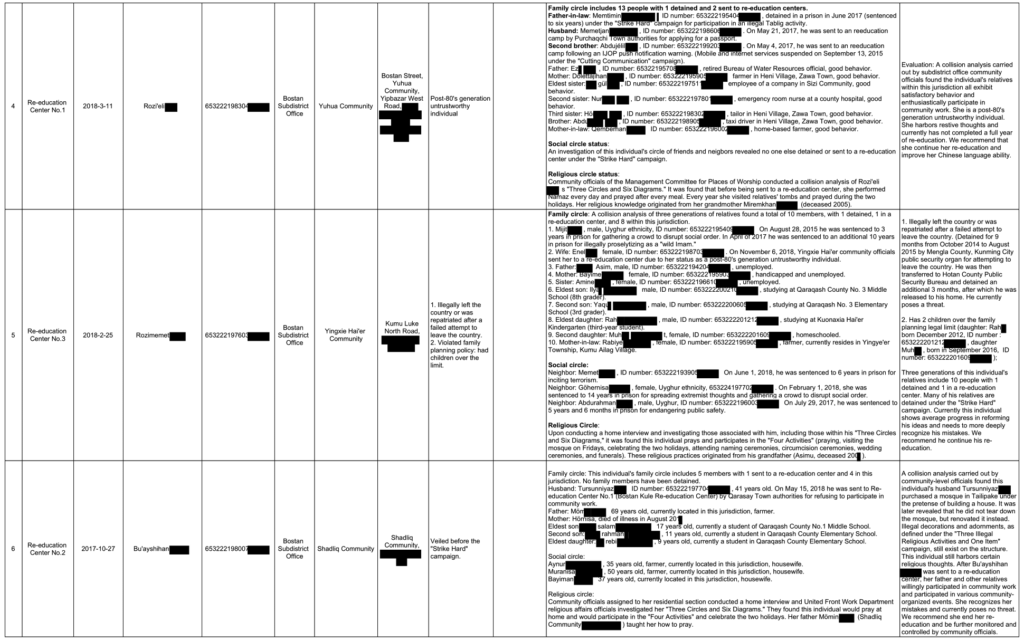
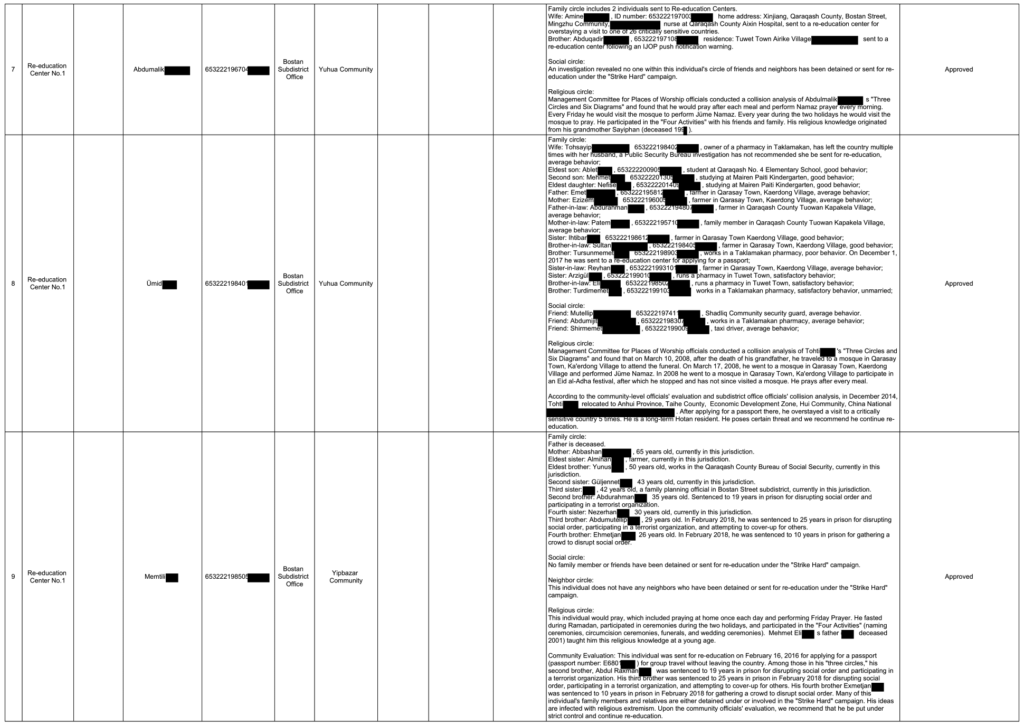
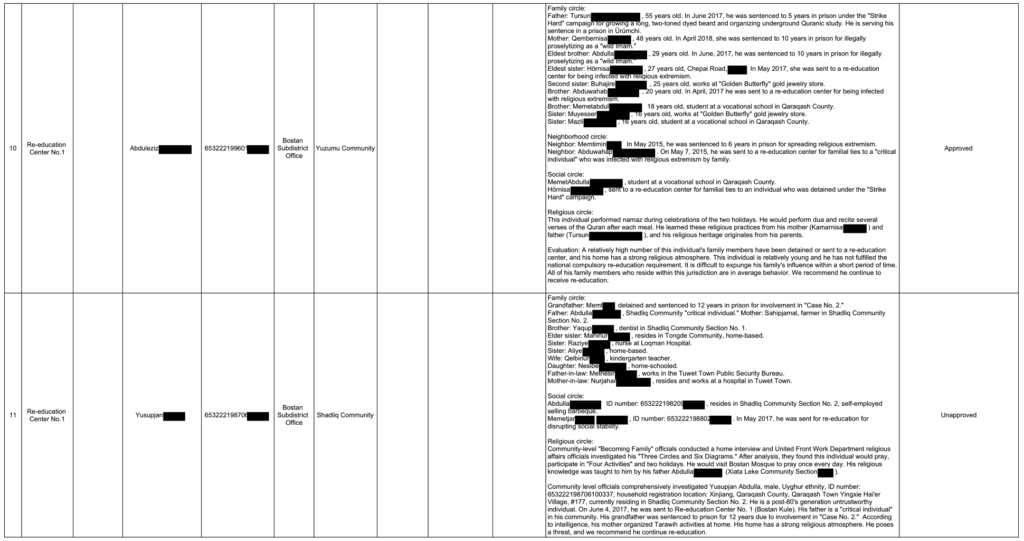

| Type of Reason | Reason | Original Chinese | Number |
| Birth policy violations | Gave birth to X number of extra children/person who violated birth policies, X number of extra births | 超生X孩/违反计划生育法超生X胎人员 | 113 |
| Did not implement 3-year birth spacing policy | 未落实计划生育三年间隔生育政策 | 1 | |
| Provided fake abortion certificate | 提供虚假流产证明 | 1 | |
| Unsafe post 80s, 90s, or 00s person | Unsafe post 80s, 90s, or 00s person | 80/90/00后不放心人员 | 91 |
| Ex-convict or other past law violation | Normal/dangerous type ex-convict | 一般/危安类刑满释放人员 | 29 |
| Law and order type ex-convict | 治安类刑满释放人员 | 1 | |
| Person diverted from detention center | 看守所分流人员 | 1 | |
| Committed minor offense, not prosecuted | 构成轻微犯罪,未追究法律责任的人员 | 1 | |
| Person who took drugs | 吸毒人员 | 3 | |
| Person under special management | 列管特殊群体人员 | 1 | |
| Domestic violence | 构成家暴行为/家庭暴力人员 | 2 | |
| Witness in a fraud case | 行骗案件受害者证人 | 1 | |
| Operated a music business without a license and without paying taxes | 音乐创业期间,没有办营业执照,没有交税,属于非法经 | 1 | |
| Wore veil/wife wore veil/had beard | Wore a veil/ wore veil before strike hard | 蒙面/ 严打前蒙面 | 6 |
| Wore a veil and “jilbab”/burqa | 蒙面,穿“吉里巴甫”服人员/ 穿罩袍人员 | 3 | |
| Wife wore a veil | 妻子蒙面 | 11 | |
| Had a beard/ had a beard before strike hard | 以前留胡子/严打前留胡子 | 12 | |
| Had a beard, wore short trousers, Wahabi thinking | 留胡子,穿短裤, 有瓦哈比思想 | 1 | |
| Applied for passport | Applied for passport (and didn’t leave the country) | 办理护照人员(未出境人员) | 24 |
| A household where many people applied for passports | 一户多人办理护照人员 | 1 | |
| Religiousextremist thought infection | Household has a thick religious atmosphere, susceptible to religious extremist thought infection | 家庭宗教氛围浓厚,易受宗教极 端思想感染人员 | 5 |
| Person with religious extremist thought infection | 宗教极端思想感染人员 | 9 | |
| Influenced by religious extremist thinking | 受宗教极端思想的影响 | 1 | |
| Slightly infected by religious extremist thought | 受宗教极端思想感染轻微人员 | 1 | |
| Received religious thinking infection unsafe post 90s person | 受宗教思想感染90后不放心人员 | 1 | |
| Thinking unstable, ability to resist religious infiltration low | 思想不稳定,宗教极端思想渗透抵抗能力较低 | 1 | |
| Person spreading extremist thinking | 传播极端思想被遣返人员 | 1 | |
| Reason related to religious practice | Unofficial hajj | 零散朝觐人员 | 10 |
| Restaurant not open during Ramadan | 在斋月期间饭馆没有正常营业 | 1 | |
| Gave to mosque | 给清真寺积极捐款人员 | 1 | |
| Provided space for illegal lectures | 提供非法讲经场所 | 1 | |
| Illegally studied religion | 非法教学经人员 | 1 | |
| Attended illegal religious activities before the strike hard campaign | 严打前参加非法宗教活动 | 1 | |
| Provided space for illegal religious activities | 为他人提供场所进行非法宗教活 动 | 2 | |
| Unpunished parent or guardian of a minor who attended religious activities | 参加非法宗教活动未成年人的父 母或其他法定监护人员中未打击 人员 | 1 | |
| Attended illegal religious classes over the age of 16 | 参加非法教经班时16岁以上的人 员 | 1 | |
| Attended illegal classes under the age of 16 | 非法学经时16岁以下的未成年人 | 1 | |
| Sent son/daughter to illegal religious classes | 送儿子非法学经/ 送未成年子女学经 | 2 | |
| Attended illegal tabiq (preaching) | 参加非法台比力克 | 1 | |
| International travel | A returned person/ suspicious returned person | 防回流人员/形迹可疑回流人员 | 16 |
| Went to one of the 26 sensitive countries, suspicious return person | 出境至26重点敏感国家逾期返回 形迹可疑人员 | 2 | |
| Illegal exit or attempt to return | 非法出境人员或非法出境未遂被 遣返人员 | 1 | |
| Sent by the Public Security Bureau, went to sensitive countries 5 times | 公安审查转培训人员,5次往返 重点国家 | 1 | |
| Related to prisoner | Related to a prisoner | 收押人员亲属 | 2 |
| Related to a “strike hard” prisoner | 严打收押人员亲属 | 10 | |
| Movements within China | Abnormal movements, thinking difficult to grasp, complex communications | 行动轨迹异常,思想难掌握,人 际交往复杂 | 1 |
| Person who moved household registration to inland and lived in Qaraqash for a long time | 户籍迁入内地,人在墨玉长期生 活人员 | 1 | |
| This person engaged in business and labor activities outside since 2004, during their time outside their communication and movements were relatively complex, they did not ask permission to leave, and their whereabouts could not be grasped, was labeled an unsafe post-80s person by the shequ | 该人从2004年起一直在外从事经商和务工等活动,外出期间人际交往和活动轨迹比较复杂,也不落实请销假措施,行踪不宜掌握, 被社区列为80后不放心人员 | 1 | |
| 7.5 diverted person | 7·5分流人员 | 3 | |
| Left without permission, went to Urumchi without authorization | 未向原户籍地请假,擅自到乌市 | 1 | |
| A person with two households | 双户人员 | 1 | |
| Two-faced official | Two-faced official | 两面性干部 | 3 |
| Official who did namaz (prayer) at home | 国家干部在家做乃玛孜 | 1 | |
| Official who attended illegal preaching | 国家干部参加非法台比力克 | 1 | |
| Did not obey community (shequ) personnel | Did not obey shequ personnel | 不服从社区管理人员 | 4 |
| Related to someone outside of the country | Family fled outside of country | 境外追逃人员亲属 | 3 |
| Family of someone who illegally left the country | 非法出境人员亲属 | 1 | |
| Possessed or watched illegal media | Kept illegal religious books / Illegal books hidden in the home | 非法存留非法宗教书籍/ 家中藏有非法书籍 | 2 |
| From October 2011 to July 2012, during the training session at Beijingagricultural vocational college, he watched illegal religious videos with others thatTursuntohti X downloaded on his computer. | 2011年10月至2012年7月在北京农业职业学院培训期间与他人一起观看图尔荪托合提·X用电脑下载非法宗教视频 | 1 | |
| Suspected of downloading illegal terrorist or other religious extremist audio or video | 具有观看下载传播暴恐音视频或 其他类宗教极端音视频的嫌疑 | 1 | |
| Accidentally clicked on an overseas website on their phone | 手机点击网站链接无意登陆境外 网站 | 1 | |
| Fraudulent marriage certificate | Married with a fake marriage certificate | 持假结婚证结婚的人员 | 1 |
| Fraudulently obtained marriage certificate as a minor | 未成年骗取结婚证结婚 | 1 | |
| Illegal nika (Islamic marriage ceremony), married with a fake marriage certificate | 该人非法念尼卡持假结婚证结婚 | 1 | |
| Overseas communication | Pushed by Public Security Bureau for overseas communication | 公安机关推送境外通联 | 1 |
| Overseas communication | 境外通联 | 1 | |
| _______________________________________________________________________________________________________ | _________________________________________ |
FEATURED VIDEO
Atrocities Against Women in East Turkistan: Uyghur Women and Religious Persecution
Watch UHRP's event marking International Women’s Day with a discussion highlighting ongoing atrocities against Uyghur and other Turkic women in East Turkistan.

